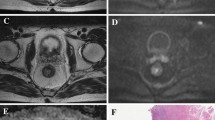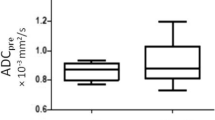Abstract
Purpose
To assess the complementary prognostic value of pre-treatment tumor apparent diffusion coefficient (ADC) for the prediction of tumor recurrence in patients with rectal cancer.
Methods
From March 2012 to March 2013, a total of 128 patients with mid/lower rectal cancer who underwent pre-treatment rectal MRI were enrolled in this retrospective study. Two radiologists in consensus evaluated conventional imaging features (Cimg) in pre-treatment rectal MRI: tumor height from anal verge (≤5 cm vs. >5 cm), T stage (high vs. low), the presence or absence of lymph node metastasis, mesorectal fascia invasion, and extramural venous invasion. The mean tumor ADC values (TumorADC) based on high b-value (0, 1000 × 10−3 mm2/s) diffusion weight images were extracted. A multivariate Cox proportional hazard (CPH) regression was performed to evaluate the association of Cimg and TumorADC with the 3-year local recurrence (LR) rate. Predictive performance of two multivariate CPH models (Cimg only vs. Cimg + TumorADC) was compared using Harrell’s c index (HCI).
Results
TumorADC (Adjusted HR, 7.830; 95% CI 3.937–15.571) and high T stage (Adjusted HR, 8.039; 95% CI 2.405–26.874) were independently associated with the 3-year LR rate. The CPH model generated with T stage + TumorADC (HCI, 0.820; 95% CI 0.708–0.932) showed significantly higher HCI than that with T stage only (HCI, 0.742; 95% CI 0.594–0.889) (P = 0.009).
Conclusions
In patients with mid/lower rectal cancer, integrating TumorADC to Cimg increases predictive performance of the CPH model than that with Cimg alone for the prediction of LR within 3 years after surgery.



Similar content being viewed by others
Abbreviations
- DWI:
-
Diffusion-weighted image
- ADC:
-
Apparent diffusion coefficient
- CR:
-
Complete remission
- PCRT:
-
Preoperative chemoradiotherapy
- MRI:
-
Magnetic resonance imaging
- MRF:
-
Mesorectal fascia
- ROI:
-
Region of interest
- TumorADC :
-
Mean pre-treatment tumor ADC value
- EMVI:
-
Extramural venous invasion
- LN:
-
Lymph node
- CT:
-
Computed tomography
- dRFS:
-
Distant relapse-free survival
- LR:
-
Local recurrence
- Cimg :
-
Conventional imaging feature
- CPH:
-
Cox proportional hazard
- HR:
-
Hazard ratio
- CI:
-
Confidence interval
- HCI:
-
Harrell’s c index
- AIC:
-
Akaike information criteria
References
Barbaro B, Vitale R, Valentini V, et al. (2012) Diffusion-weighted magnetic resonance imaging in monitoring rectal cancer response to neoadjuvant chemoradiotherapy. Int J Radiat Oncol Biol Phys 83(2):594–599. doi:10.1016/j.ijrobp.2011.07.017
Kim SH, Lee JM, Hong SH, et al. (2009) Locally advanced rectal cancer: added value of diffusion-weighted MR imaging in the evaluation of tumor response to neoadjuvant chemo- and radiation therapy. Radiology 253(1):116–125. doi:10.1148/radiol.2532090027
Lambregts DM, Vandecaveye V, Barbaro B, et al. (2011) Diffusion-weighted MRI for selection of complete responders after chemoradiation for locally advanced rectal cancer: a multicenter study. Ann Surg Oncol 18(8):2224–2231. doi:10.1245/s10434-011-1607-5
Ippolito D, Monguzzi L, Guerra L, et al. (2012) Response to neoadjuvant therapy in locally advanced rectal cancer: assessment with diffusion-weighted MR imaging and 18FDG PET/CT. Abdom Imaging 37(6):1032–1040. doi:10.1007/s00261-011-9839-1
Ganten MK, Schuessler M, Bauerle T, et al. (2013) The role of perfusion effects in monitoring of chemoradiotherapy of rectal carcinoma using diffusion-weighted imaging. Cancer Imaging 13(4):548–556. doi:10.1102/1470-7330.2013.0045
Sun YS, Zhang XP, Tang L, et al. (2010) Locally advanced rectal carcinoma treated with preoperative chemotherapy and radiation therapy: preliminary analysis of diffusion-weighted MR imaging for early detection of tumor histopathologic downstaging. Radiology 254(1):170–178. doi:10.1148/radiol.2541082230
Elmi A, Hedgire SS, Covarrubias D, et al. (2013) Apparent diffusion coefficient as a non-invasive predictor of treatment response and recurrence in locally advanced rectal cancer. Clinical Radiol 68(10):e524–e531. doi:10.1016/j.crad.2013.05.094
Monguzzi L, Ippolito D, Bernasconi DP, et al. (2013) Locally advanced rectal cancer: value of ADC mapping in prediction of tumor response to radiochemotherapy. Eur J Radiol 82(2):234–240. doi:10.1016/j.ejrad.2012.09.027
Cho SH, Kim GC, Jang YJ, et al. (2015) Locally advanced rectal cancer: post-chemoradiotherapy ADC histogram analysis for predicting a complete response. Acta Radiol 56(9):1042–1050. doi:10.1177/0284185114550193
Xie H, Sun T, Chen M, et al. (2015) Effectiveness of the apparent diffusion coefficient for predicting the response to chemoradiation therapy in locally advanced rectal cancer: a systematic review and meta-analysis. Medicine (Baltimore) 94(6):e517. doi:10.1097/MD.0000000000000517
Giganti F, Orsenigo E, Esposito A, et al. (2015) Prognostic role of diffusion-weighted MR imaging for resectable gastric cancer. Radiology 276(2):444–452. doi:10.1148/radiol.15141900
Kurosawa J, Tawada K, Mikata R, et al. (2015) Prognostic relevance of apparent diffusion coefficient obtained by diffusion-weighted MRI in pancreatic cancer. J Magn Resonan Imaging: JMRI. doi:10.1002/jmri.24939
Zhang Y, Liu X, Zhang Y, et al. (2015) Prognostic value of the primary lesion apparent diffusion coefficient (ADC) in nasopharyngeal carcinoma: a retrospective study of 541 cases. Sci Rep 5:12242. doi:10.1038/srep12242
Lambrecht M, Van Calster B, Vandecaveye V, et al. (2014) Integrating pretreatment diffusion weighted MRI into a multivariable prognostic model for head and neck squamous cell carcinoma. Radiother Oncol 110(3):429–434. doi:10.1016/j.radonc.2014.01.004
Akashi M, Nakahusa Y, Yakabe T, et al. (2014) Assessment of aggressiveness of rectal cancer using 3-T MRI: correlation between the apparent diffusion coefficient as a potential imaging biomarker and histologic prognostic factors. Acta Radiol 55(5):524–531. doi:10.1177/0284185113503154
Curvo-Semedo L, Lambregts DM, Maas M, et al. (2012) Diffusion-weighted MRI in rectal cancer: apparent diffusion coefficient as a potential noninvasive marker of tumor aggressiveness. J Magn Reson Imaging: JMRI 35(6):1365–1371. doi:10.1002/jmri.23589
Nasu K, Kuroki Y, Minami M (2012) Diffusion-weighted imaging findings of mucinous carcinoma arising in the ano-rectal region: comparison of apparent diffusion coefficient with that of tubular adenocarcinoma. Jpn J Radiol 30(2):120–127. doi:10.1007/s11604-011-0023-x
Nougaret S, Reinhold C, Mikhael HW, et al. (2013) The use of MR imaging in treatment planning for patients with rectal carcinoma: have you checked the “DISTANCE”? Radiology 268(2):330–344. doi:10.1148/radiol.13121361
Beets-Tan RG, Lambregts DM, Maas M, et al. (2013) Magnetic resonance imaging for the clinical management of rectal cancer patients: recommendations from the 2012 European Society of Gastrointestinal and Abdominal Radiology (ESGAR) consensus meeting. Eur Radiol 23(9):2522–2531. doi:10.1007/s00330-013-2864-4
Gollub MJ, Lakhman Y, McGinty K, et al. (2015) Does gadolinium-based contrast material improve diagnostic accuracy of local invasion in rectal cancer MRI? A multireader study. AJR Am J Roentgenol 204(2):W160–W167. doi:10.2214/AJR.14.12599
Gu J, Khong PL, Wang S, et al. (2011) Quantitative assessment of diffusion-weighted MR imaging in patients with primary rectal cancer: correlation with FDG-PET/CT. Mol Imaging Biol 13(5):1020–1028. doi:10.1007/s11307-010-0433-7
Sohn B, Lim JS, Kim H, et al. (2015) MRI-detected extramural vascular invasion is an independent prognostic factor for synchronous metastasis in patients with rectal cancer. Eur Radiol 25(5):1347–1355. doi:10.1007/s00330-014-3527-9
Kim JH, Beets GL, Kim MJ, Kessels AG, Beets-Tan RG (2004) High-resolution MR imaging for nodal staging in rectal cancer: are there any criteria in addition to the size? Eur J Radiol 52(1):78–83. doi:10.1016/j.ejrad.2003.12.005
Brown G, Richards CJ, Bourne MW, et al. (2003) Morphologic predictors of lymph node status in rectal cancer with use of high-spatial-resolution MR imaging with histopathologic comparison. Radiology 227(2):371–377. doi:10.1148/radiol.2272011747
Taylor FG, Quirke P, Heald RJ, et al. (2014) Preoperative magnetic resonance imaging assessment of circumferential resection margin predicts disease-free survival and local recurrence: 5-year follow-up results of the MERCURY study. J Clin Oncol 32(1):34–43. doi:10.1200/JCO.2012.45.3258
Smith NJ, Shihab O, Arnaout A, Swift RI, Brown G (2008) MRI for detection of extramural vascular invasion in rectal cancer. AJR Am J Roentgenol 191(5):1517–1522. doi:10.2214/AJR.08.1298
Twelves C, Wong A, Nowacki MP, et al. (2005) Capecitabine as adjuvant treatment for stage III colon cancer. N Engl J Med 352(26):2696–2704. doi:10.1056/NEJMoa043116
Fried DV, Mawlawi O, Zhang L, et al. (2015) Stage III non-small cell lung cancer: prognostic value of FDG PET quantitative imaging features combined with clinical prognostic factors. Radiology 142920. doi:10.1148/radiol.2015142920
Newson R (2010) Comparing the predictive power of survival models using Harrell’s c or Somers’ D. Stata J 10(3):339–358.
Sala E, Micco M, Burger IA, et al. (2015) Complementary prognostic value of pelvic magnetic resonance imaging and whole-body fluorodeoxyglucose positron emission tomography/computed tomography in the pretreatment assessment of patients with cervical cancer. Int J Gynecol Cancer 25(8):1461–1467. doi:10.1097/IGC.0000000000000519
Sun Y, Tong T, Cai S, et al. (2014) Apparent Diffusion Coefficient (ADC) value: a potential imaging biomarker that reflects the biological features of rectal cancer. PloS One 9(10):e109371. doi:10.1371/journal.pone.0109371
Bollineni VR, Kramer G, Liu Y, Melidis C, deSouza NM (2015) A literature review of the association between diffusion-weighted MRI derived apparent diffusion coefficient and tumour aggressiveness in pelvic cancer. Cancer Treat Rev 41(6):496–502. doi:10.1016/j.ctrv.2015.03.010
Author information
Authors and Affiliations
Corresponding author
Ethics declarations
Funding
This study was not funded.
Conflicts of interest
All authors declare no existing conflict of interest.
Ethical approval
This retrospective study involving human was approved by the institutional research committee, complying with the 1964 Helsinki declaration and its later amendments or comparable ethical standards. Informed consent was waived.
Electronic Supplementary Material
Below is the link to the electronic supplementary material.
Rights and permissions
About this article
Cite this article
Moon, S.J., Cho, S.H., Kim, G.C. et al. Complementary value of pre-treatment apparent diffusion coefficient in rectal cancer for predicting tumor recurrence. Abdom Radiol 41, 1237–1244 (2016). https://doi.org/10.1007/s00261-016-0648-4
Published:
Issue Date:
DOI: https://doi.org/10.1007/s00261-016-0648-4




